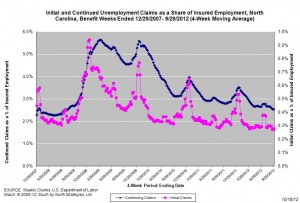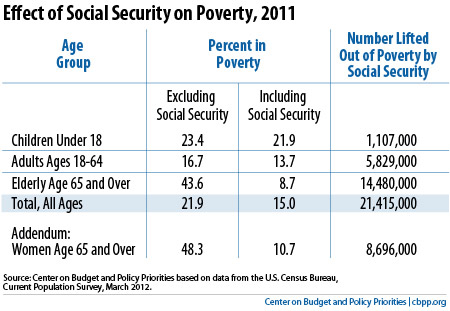State Labor Market Sends Mixed Signals In Sept.
CHAPEL HILL (October 19, 2012) – North Carolina recorded no net job growth in September, as a decline in public-sector payrolls offset almost all of an increase in private-sector payrolls. Over the month, the state gained 100 more payroll jobs than it lost (+/-0.0 percent). At the same time, the number of employed North Carolinians rose, and both the number of unemployed persons and the statewide unemployment rate fell. These findings come from new data released by the Labor and Economic Analysis Division of the NC Department of Commerce.
“North Carolina’s labor market sent mixed signals in September,” said John Quinterno, a principal with South by North Strategies, Ltd., a research firm specializing in economic and social policy. “The overall number of jobs in the state held steady at 3.95 million, but the labor force grew in size and the number of employed persons rose. In the process, the statewide unemployment rate fell to 9.6 percent from 9.7 percent.”
In September, North Carolina employers added 100 more jobs than they cut (+/-0.0 percent). Private-sector payrolls netted 1,500 positions (+/-0.0 percent), while public-sector payrolls shed 1,400 jobs (-0.2 percent), due primarily to reductions in state government payroll levels. Within the private sector, professional and business services gained the most jobs (+6,000, +1.2 percent), with virtually all of the growth occurring in the administrative and waste management subsector. The leisure and hospitality sector netted 2,200 jobs (+0.5 percent), followed by construction (+1,100, +0.7 percent). At the other end of the spectrum, the finance sector shed the most jobs (-3,600 positions, -1.7 percent), followed by the trade, transportation, warehousing, and utilities sector (-3,000, -0.4 percent) and manufacturing (-1,200, -0.3 percent).
A revision to the August payroll data found that the state gained fewer jobs than first estimated (+600 versus +1,100). With that revision, North Carolina now has, on net, 223,700 fewer payroll positions (-5.4 percent) than it did in December 2007. Since bottoming out in February 2010, the state has netted an average of 3,310 payroll jobs per month, resulting in a cumulative gain of 102,600 positions (+2.7 percent).
“North Carolina’s labor market began 2012 on a strong footing, but it has stumbled as the year has progressed,” noted Quinterno. “Since March, the state’s labor market has given back 23.5 percent of the job gains recorded during the year’s first quarter. The general pattern in 2012 has been for job losses in the public sector to offset modest private-sector gains—a pattern especially evident in the year’s third quarter. Had public payroll levels held constant in 2012, the state now would have 5,800 more jobs, all else being equal.”
The household data for September offered a more positive view of labor market conditions. Last month, the unemployment rate fell to 9.6 percent, and the number of unemployed persons declined by 3,576 persons (-0.8 percent). Moreover, the number of employed North Carolinians rose (+29,232, +0.7 percent), as did the overall size of the labor force (+25,656, +0.6 percent).
Over the past year, the total number of unemployed North Carolinians has fallen by 48,682 persons (-9.8 percent), and the number of employed persons has grown by 61,656 persons (+1.5 percent). Put differently, more people report having jobs that was the case a year ago.
That said, the increase in employment is weak relative to the severity of the employment problems facing the state. North Carolina’s unemployment rate has exceeded 9 percent in every month since January 2009 and has ranged as high as 11.4 percent. Compared to December 2007, which was when the “Great Recession” began, the statewide unemployment rate is 4.6 percentage points higher, and the number of unemployed North Carolinians is 96 percent greater. During the first nine months of 2012, an average of 450,304 North Carolinians were unemployed in any given month.
Other troubling labor market indicators include a statewide unemployment rate that has exceeded 10 percent in 35 of the last 45 months and depressed labor force participation rates and employment-to-population ratios. Although both the labor force participation rate and employment-to-population ratio rose in September after having declined for six straight months, both measures remain near 36-year lows.
“Job growth in North Carolina has lagged over the course of 2012,” observed Quinterno. “Despite modest overall growth in the private sector, the state has just 0.5 percent more jobs than it did last December and only 0.8 percent more jobs than it did one year ago. While the number of employed persons has increased, unemployment remains extremely elevated.”



 Email Sign-Up
Email Sign-Up RSS Feed
RSS Feed